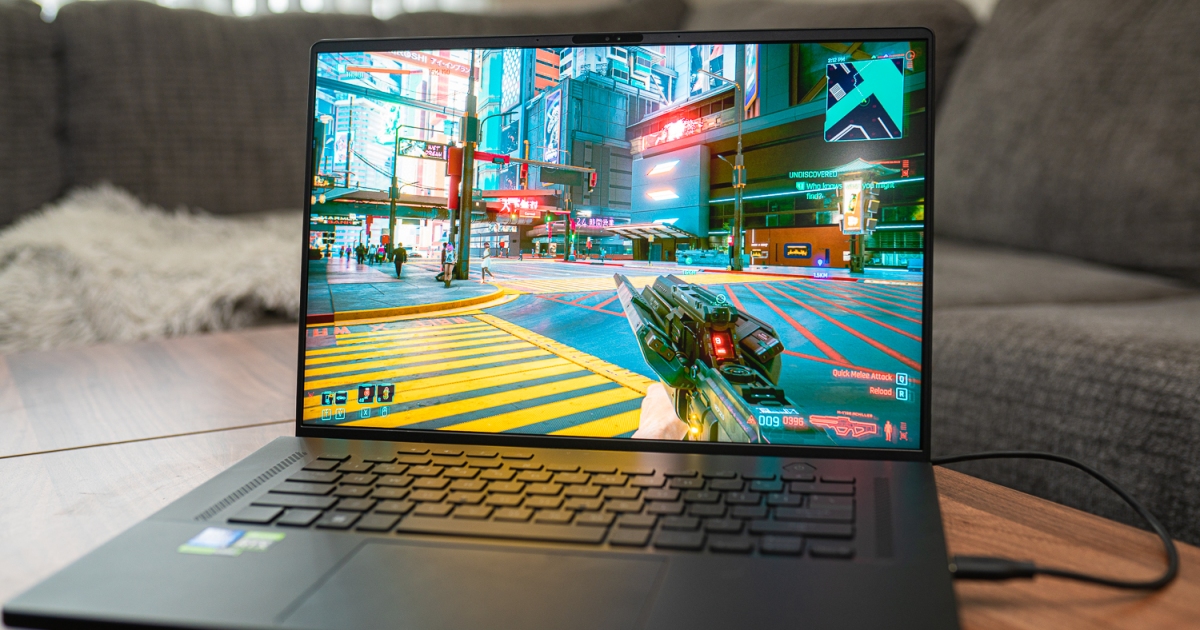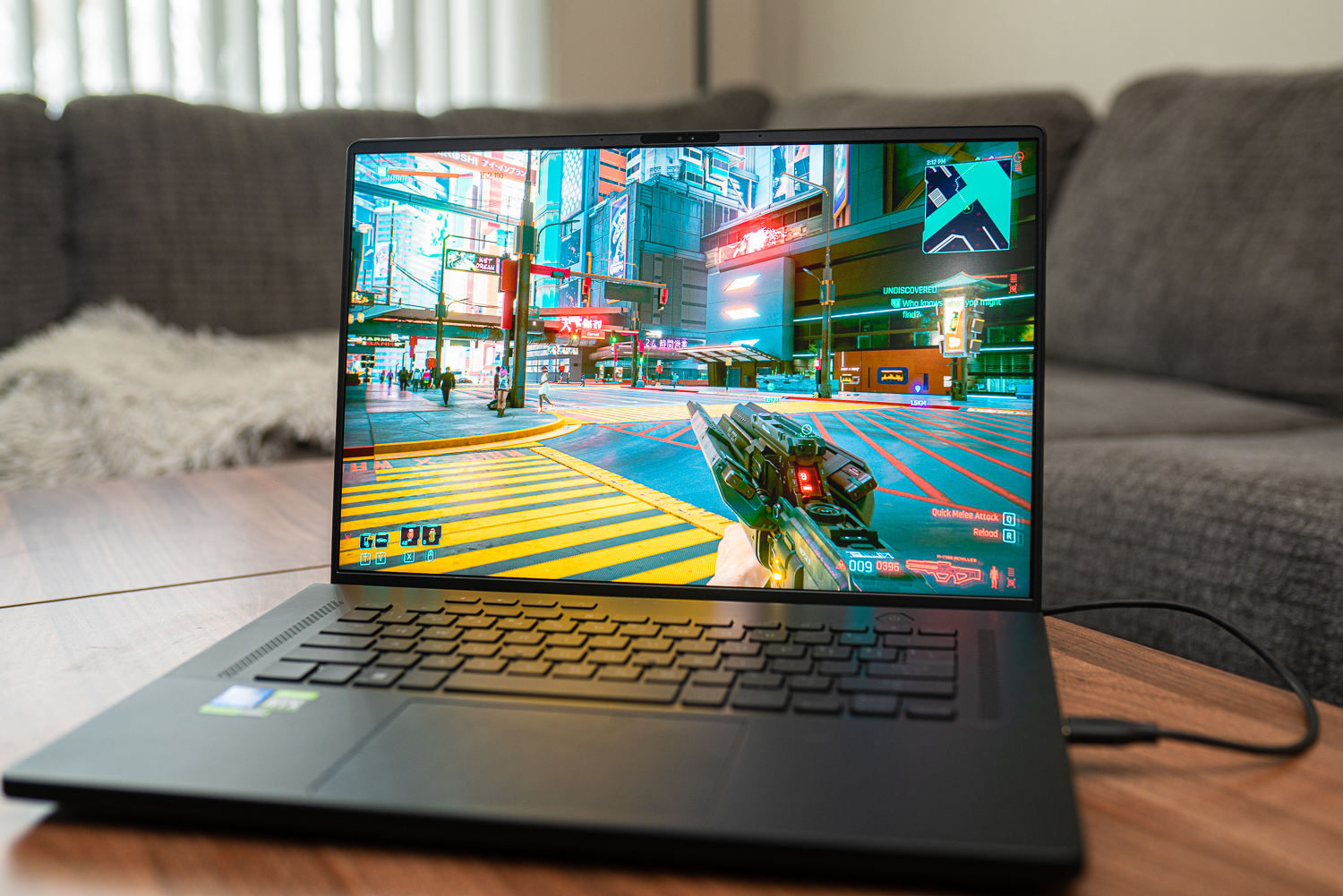
Asus ROG Zephyrus M16
MSRP $3,500.00
“The Asus ROG Zephyrus M16 is powerful and highly portable, but skip the RTX 4090 configuration.”
Pros
- Smart and stylish design
- Excellent keyboard
- Powerful, high-end Nvidia graphics
- Beautiful 240Hz screen
- AniMe matrix adds a lot of flair
Cons
- RTX 4090 can’t shine in this size
- Battery life is a bit weak
There’s no where else to start this review — the Asus ROG Zephyrus M16 is one of the best gaming laptops you can buy. However, its spec sheet doesn’t say why this laptop is so impressive, and my testing shows that the Nvidia RTX 4090 you can configure this machine with is effectively wasted money.
Smart design and thermal management helps the Zephyrus M16 stand out in this new class of 16-inch gaming laptops, along with a solid keyboard and great audio. Performance holds up too, assuming you settle for a lower class of Nvidia GPU. There’s no doubt the RTX 4090 is a powerful mobile graphics card, but it’s not given a chance to fully shine in Asus’ machine.
Asus ROG Zephyrus M16 specs

Asus offers several configurations of the Zephyrus M16, but they all fit in a narrow range. Regardless of the configuration you choose, you’re getting a 14-core Intel Core i9-13900H, 32GB of DDR5-4800 memory, and 2TB of PCIe 4.0 SSD storage. You can go up to 64GB of DDR5, but you need to upgrade the memory yourself.
There are two differences between models — the graphics card and the AniMe matrix. I’ll dig more into the AniMe matrix in the next section, but for the graphics card, you can choose between an RTX 4070, RTX 4080, or RTX 4090, each of which have a version with and without the AniMe matrix. My review model is strapped with the RTX 4090 and the AniMe matrix for $3,500, but cheaper models go for under $2,000.
| Asus ROG Zephyrus M16 | |
| Dimensions | 13.9 inches x 9.7 inches x 0.78 inches |
| Weight | 5.07 pounds |
| Processor | Intel Core i9-13900H |
| Graphics | Nvidia GeForce RTX 4090 |
| RAM | 32GB DDR5-4800 |
| Display | 16-inch 16:10 WQXGA (2,560 x 1,600), 240Hz |
| Storage | 2TB PCIe 4.0 SSD |
| Touch | No |
| Ports | 2 x USB-A 3.2 Gen 1 1 x USB-C 3.2 Gen 2 1 x USB-C with Thunderbolt 4 1 x HDMI 2.1 1 x 3.5mm audio jack |
| Wireless | Wi-Fi 6E and Bluetooth 5.1 |
| Webcam | 1080p |
| Operating system | Windows 11 |
| Battery | 90 watt-hours |
| Price | $3,500 |
You have access to the same port selection across all models, which is excellent. In addition to two USB 3.2 Gen 2 ports, you also get a single USB-C supporting DisplayPort and power delivery, as well as a Thunderbolt 4 port with the same support. In addition, there’s a full-sized HDMI 2.1 port and a micro SD card reader. It even supports fast charging, allowing you to get 50% of the battery life back in 30 minutes.
Typical of Asus’ Zephyrus offerings, the M16 feels balanced in its port selection and configuration. From the 2TB of storage to the high-end (but not flagship) CPU, it’s a machine built for a specific purpose rather than the free-for-all configuration options you typically see with a laptop like the Alienware x17 R2. I do wish there was another processor option. As I’ll dig into below, the processor feels a bit too overpowered for gaming while falling a bit behind in productivity compared to other high-end 16-inch laptops.
Smart and stylish design
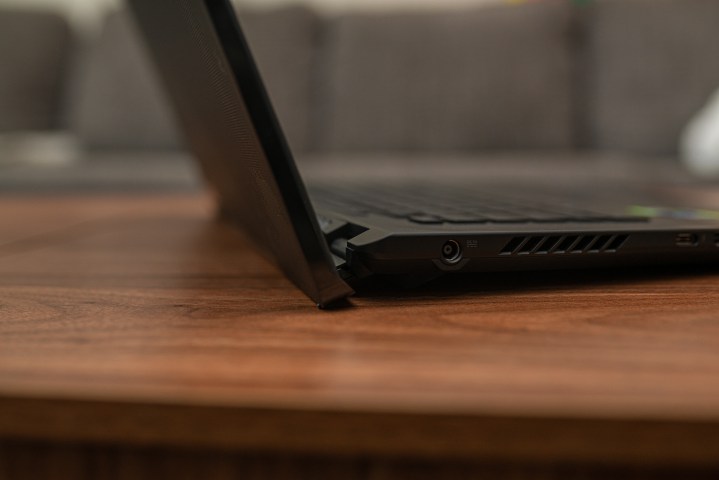
My favorite aspect of recent Zephyrus laptops, and especially the 2023 M16, is how the design is smart and stylish in equal parts. As far as the smart part, Asus stuck with the hinge it has used on the past few Zephyrus designs, which slightly angles the keyboard up and allows plenty of room for ventilation.
It’s more comfortable to type on than a typical clamshell design, but it’s the thermal performance that shines. The bottom of the display has pads that the laptop rests on while it’s open, opening up a ton of ventilation at the top of the machine and allowing a thin layer of airflow under the laptop. It may seem like a small change, but it does wonders for noise. Even in its default performance mode, the Zephyrus M16 was comfortably quiet to game on.
The stylish part comes in the form of the clean top of the laptop and the AniMe matrix. There’s the same subtle branding in the bottom-left corner of the lid that makes the lid feel sleek and classy. This is a gaming laptop, there’s no doubt about that in the design. But while machines like like the Alienware x14 scream that fact from the rooftop, the Zephyrus M16 whispers it.

That’s assuming you leave the AniMe matrix turned off, though. When it’s on, 18,710 precision-machined holds allow a grid of LED lighting to play animations, display the time, and even light up with an audio visualizer. You’re free to add your own text and images as well, personalizing the grid for your machine. This is the signature feature of the Zephyrus range, and I wouldn’t have it any other way. Sure, it goes against the subtle branding the machine maintains otherwise, but let’s be honest: it looks downright cool.
Smart thermal design and stylish branding meet in a remarkably portable package too. Even at 16 inches, the Zephyrus M16 comes in under 5 pounds and less than an inch thick. I wouldn’t carry most 15-inch laptops in my backpack, let alone a 16-inch gaming machine, but I’d be happy to lug around the Zephyrus M16.
Screen
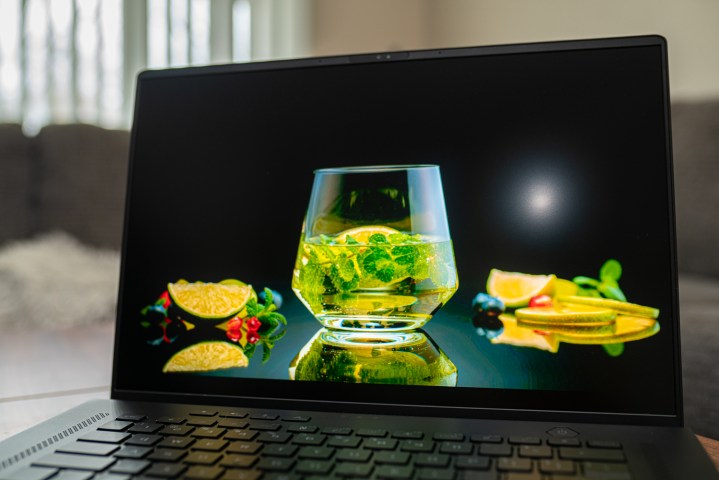
The Zephyrus M16 is one of the first laptops from Asus to boast ROG Nebula HDR, a display certification that raises the bar for laptop gaming displays. And it’s a success on the Zephyrus M16, even if the display can’t reach the perfect black levels present on the Asus Zenbook S 13 OLED.
It’s a 16:10 display with a 2,560 x 1,600 resolution, Pantone Validation for color, and a 240Hz refresh rate. That’s great, but the big boost here is dense local dimming. Asus says the monitor has 1,024 local dimming zones and a peak brightness of 1,100 nits, which are specs on the level of a high-end gaming monitor like the Samsung Odyssey Neo G8.
Asus isn’t lying on the spec sheet, either. With its preinstalled color profile, I measured 100% coverage of sRGB and DCI-P3 colors spaces, which is more color coverage than even an OLED display like the LG UltraGear OLED 27. Even better, the color error was 1.4 overall, with the highest value being 2.7. That’s not professional caliber, but the display is color accurate enough for photo and video editing.
It didn’t reach 1,100 nits, but the display still topped out at 870 nits. If a laptop can manage 400 nits, that’s usually impressive. Similarly, I measured a contrast ratio of 20,000:1, beating even high-end monitors with local dimming like the Sony InZone M9.
The display is one of the biggest selling points of the Zephyrus M16. Not only is it exceptional for HDR,but the fast 240Hz refresh rate makes it a solid option for competitive gaming as well. I would have preferred a faster response time (Asus claims 3 milliseconds), but there’s so much else here to appreciate.
Keyboard and trackpad

High-end gaming laptops like the Corsair Voyager a1600 have adopted “mechanical” keyboards co-developed with Cherry over the past several years, but the Zephyrus M16 doesn’t jump on the bandwagon. And I couldn’t be happier.
Instead of a pseudo-mechanical switch that’s prone to sticking and inconsistent travel, Asus opted to stick the same membrane keyboard it has used on the past few generations of Zephyrus laptops. You get a travel distance of 1.7mm, giving you a decent amount of room to slam against the keyboard, and that’s the perfect amount for a laptop like this.
A keyboard like the one on the MacBook Air M2 will win over the Zephyrus M16 every time, but Asus has a good baseline set here for gaming laptops. The Razer Blade 17 has a slightly more satisfying snap to keypresses, but I had no issues typing on the Zephyrus M16 for hours on end. I’ve typed tens of thousands of words on my Zephyrus G14, and this laptop uses the same keyboard.
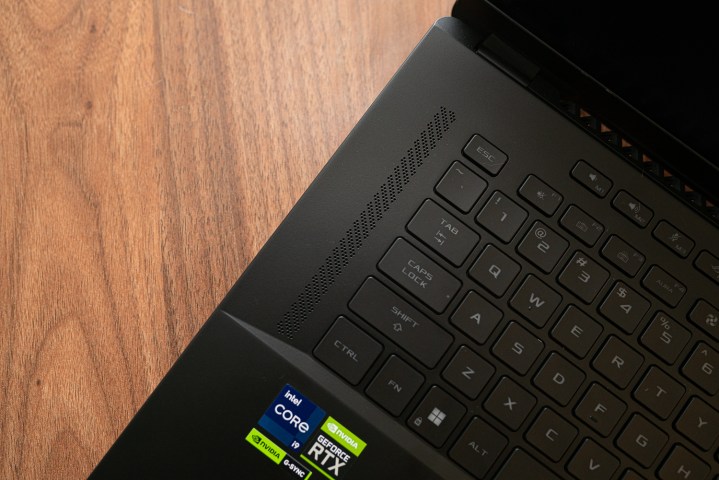
Around the keyboard, there are two speaker grilles that house six total speakers. Asus focuses on a lot of marketing buzz about Hi-Res audio and Dolby Atmos support, but the main selling point here is that the speakers just sound good. A big part of that is that they fire up from the top of the laptop, providing clarity and oomph that’s usually lost with the down-firing speaker design you see all too commonly on gaming laptops.
Processor performance
Although Asus offers several configurations for the Zephyrus M16, all of them come with an Intel Core i9-13900H. It’s a Core i9, but the chip has far fewer cores than a high-end chip like the Core i9-13980HX. You get 14 cores total, split across six performance cores and eight efficiency cores, and a boost clock of 5.4GHz.
Fewer cores makes a big difference in benchmarks like Cinebench R23, where the 24-core Core i9-13900HX inside the Lenovo Legion Pro 7i was able to outpace the Zephyrus M16 by nearly 30%. This chip isn’t unlocked for overclocking like the HX-class parts, either. With the HX part overclocked in Lenovo’s laptop, it was over 60% faster.
| Handbrake (seconds) |
Cinebench R23 (single/multi) |
PugetBench for Premiere Pro |
Geekbench (single/multi) |
|
| Asus ROG Zephyrus M16 (i9-13900H / RTX 4090) | 58 | 2,058 / 17,511 | 1,100 | N/A |
| Lenovo Legion Pro 7i (i9-13900HX / RTX 4080) |
55 | 2,096 / 22,596 | 1,151
|
2,020 / 19,041 |
| MSI GT77 Titan 2023 (Core i9-13980HX / RTX 4090) | 47 | 2,103 / 28,921 | 1,031 | 2,068 / 20,622 |
| MSI GT77 Titan (Core i9-12900HX / RTX 3080 Ti) | 56 | 1,833 / 20,007 | 883 | 1,838 / 15,655 |
| MSI GE76 Raider (Core i9-12900HK / RTX 3080 Ti) | 72 | 1,872 / 16,388 | 876 | 1,855 / 13,428 |
Cinebench shows scaling, but it doesn’t always translate into real-world performance. A good example is PCMark 10, where the Zephyrus M16 was a hair faster than Lenovo’s laptop. Similarly, the Core i9-13900H was only a hair slower in Handbrake, which is a transcoding app that generally scales to many cores.
PugetBench for Premiere Pro is on the opposite end, where the Legion Pro 7i was around 19% faster than the Zephyrus M16. However, that lower score mainly came on the back of poor timeline performance in Premiere. Asus’ laptop was ahead in every other category, but it fell behind in timeline performance by about 35%.
That sounds like a loss for the Zephyrus M16, but some context is important here. Even compared to last-gen’s Core i9-12900HX, which has more power and access to overclocking, the 13th-gen chip is faster in every benchmark. The Core i9-13900H is still a very powerful processor, though I would’ve liked to see more configuration options from Asus for shoppers who need a little more processor power out of their gaming laptop. This configuration is well-suited for gaming, but it falls behind HX parts outside of gaming.
Problematic RTX 4090
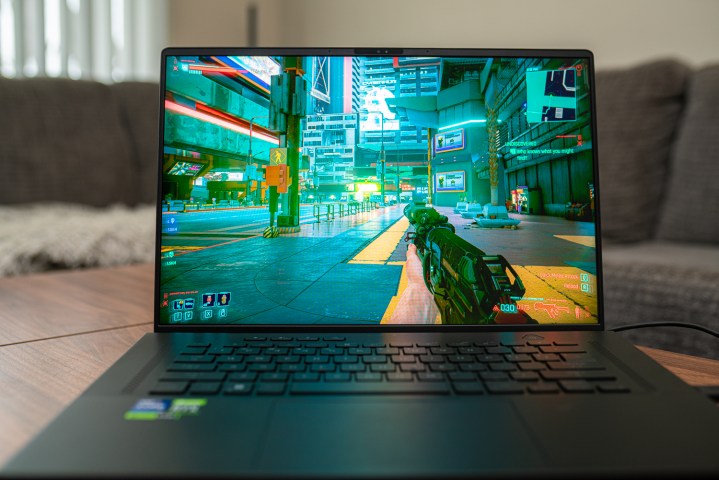
The Zephyrus M16 is a supremely powerful laptop, but I can’t recommend it with the RTX 4090 inside. The issue, as it usually does, comes down to the Total Graphics Power (TGP) afforded to Nvidia’s high-end GPU in a relatively thin laptop.
In the laptop’s default mode, the RTX 4090 is only able to draw up to 85 watts of power. You’re able to push that limit up to 150W thanks to Dynamic Boost, though at the cost of noise and thermals. Despite that, I found nearly every benchmark I ran showed that the RTX 4090 did basically nothing to improve performance over the RTX 4080 inside the Lenovo Legion Pro 7i.
| Asus ROG Zephyrus M16 (RTX 4090) | Lenovo Legion Pro 7i (RTX 4080) |
MSI GT77 Titan 2023 (RTX 4090) |
MSI GT77 Titan (RTX 3080 Ti) |
|
| 3DMark Time Spy | 18,372 | 18,382 | 20,836 | 13,361 |
| 3DMark Fire Strike | 34,898 | 32,384 | 35,827 | 29,419 |
| Assassin’s Creed Valhalla (1080p Ultra High) |
136 fps | 129 fps | 150.9 fps | 87 fps |
| Red Dead Redemption 2 (1080p Ultra) |
114 fps | 120 fps | 137 fps | 95 fps |
| Cyberpunk 2077 (1080p Ultra) |
109 fps | 113 fps | 132.7 fps | 98 fps |
At 1080p, the Lenovo machine was actually faster in Balanced mode in Red Dead Redemption 2 and Cyberpunk 2077. Performance mode brings the Zephyrus M16 closer, with the Asus laptop actually pushing ahead in Assassin’s Creed Valhalla, but the Legion Pro 7i is still faster, despite having worse specs on paper.
This isn’t an issue with Asus, which otherwise made an excellent gaming laptop. The problem comes from Nvidia’s naming for its mobile graphics cards, where situations like this one are far too common. I haven’t tested the RTX 4080 configuration, but it has access to the same amount of power, and I’d wager it gets close to the RTX 4090 in performance.
A good basis for comparison is MSI’s GT77 Titan, which thanks to MSI’s Thermal Velocity Boost, allows the mobile RTX 4090 to shine. The Zephyrus M16 is behind by around 10% in every benchmark, even when pushed in Performance mode. The GT77 Titan is much louder and larger than the Zephyrus M16, but it’s a good illustration of the problem with the RTX 4090 inside Asus’ laptop.
| Cyberpunk 2077 – Balanced | 92 fps |
| Cyberpunk 2077 – Performance | 109 fps |
| Cyberpunk 2077 – GPU overclocked | 112 fps |
This is a case of mismatching, and it makes me worry for smaller designs that also sport the RTX 4090 on the spec sheet (Asus plans to offer the GPU in the 14-inch G14, for example). I don’t want the failings of power limits to distract from the M16 as a laptop, though. Paired with the right GPU — probably an RTX 4070 or RTX 4080 based on what I’ve seen with this configuration — it’s a great gaming laptop, and Asus includes several modes to tailor your performance according to the thermal and noise profile you’re expecting.
One of the best, with the right configuration
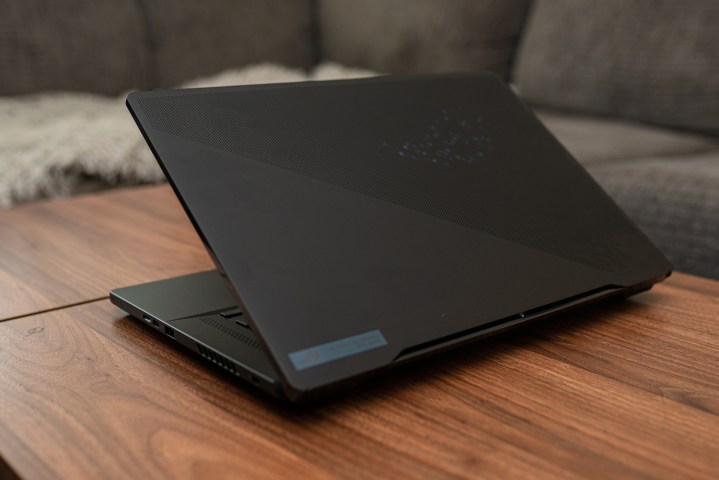
The RTX 4090 sours the Zephyrus M16, but the good news is that you can get it with other GPUs. I haven’t tested the RTX 4080 configuration, but given the size and processor, I’m suspecting that’s the winning configuration.
Outside of the GPU, there’s very little to complain about. The keyboard and chassis design are excellent, the screen beats even flagship gaming monitors, and the thermals and noise seem impossible given how much power the Zephyrus M16 has packed inside.
There are definitely machines such as the MSI GT77 Titan and Lenovo Legion Pro 7i that deliver better performance with the same hardware, but there’s not another machine that matches the balance of portability and power offered by Asus’ latest flagship.
Editors’ Recommendations
